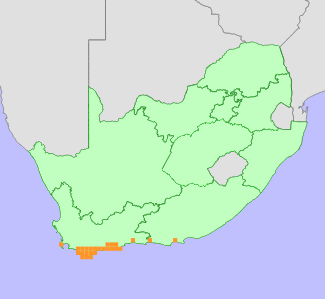|
Scientific Name | Protea susannae E.Phillips |
Higher Classification | Dicotyledons |
Family | PROTEACEAE |
Common Names | Foetid-leaf Sugarbush (e), Stinkblaarsuikerbos (a), Stinkblaar-suikerbos (a), Stink-leaf Protea (e), Stink-leaf Sugarbush (e) |
National Status |
Status and Criteria | Near Threatened A2ce; B1b(iii,v)+2b(iii,v) |
Assessment Date | 2020/06/08 |
Assessor(s) | A.G. Rebelo, H. Mtshali & L. von Staden |
Justification | Protea susannae has experienced a population reduction of nearly 30% in the past 60 years (generation length 20 years). This loss is estimated based on a 21% transformation of its habitat and 78% infestations of known subpopulations by invasive alien plants. Dense alien Acacia infestations of the habitat is causing a continuing decline. It has an extent of occurrence (EOO) of 8 671 km² and an area of occupancy (AOO) of 1 212 km², however it is known from more than 10 locations and therefore almost qualifies as Vulnerable against the thresholds for criterion A and B and is listed as Near Threatened. |
Distribution |
Endemism | South African endemic |
Provincial distribution | Western Cape |
Range | This species is endemic to the southern parts of the Western Cape Province, in South Africa, where it occurs from Stanford to Stilbaai. |
Habitat and Ecology |
Major system | Terrestrial |
Major habitats | Blombos Strandveld, Overberg Dune Strandveld, Potberg Sandstone Fynbos, North Langeberg Sandstone Fynbos, Overberg Sandstone Fynbos, Canca Limestone Fynbos, De Hoop Limestone Fynbos, Agulhas Limestone Fynbos, Elim Ferricrete Fynbos, Albertinia Sand Fynbos, Agulhas Sand Fynbos, Hartenbos Dune Thicket |
Description | It is a bottomland species occurring between limestone hills on deeper calcareous and neutral sandy soils, 20-200 m. Mature individuals are killed by fires, and only seeds survive. Wind-dispersed seeds are stored in fire-resistant inflorescences, and released after fires. It is pollinated by birds. |
Threats |
| A population reduction of 25-30% is estimated based on habitat loss in Limestone Fynbos due to agriculture and urban developments (Stanford, Gansbaai, Struisbaai, Stilbaai) in the past. About 36% of records of this species are from road verges. It is not easy to determine if they extend beyond that, because the vegetation has been ploughed up or bush cut to encourage thatching reed. Although the transformation layer records only 21% habitat loss within its range, this layer under-represents pasture in the area and with the inclusion of limestone uplands in the occurrence, it is possible that bottomlands may well exceed 60% transformation, mainly because of thatching. Data collected during the Protea Atlas Project (1996 to 2002) noted that 78% of sites were invaded (primarily by alien acacias), with 31% of sites recorded to have abundant to impenetrable levels of invasive plants. Levels of alien infestations would have only increased in the past 18 years.
Climate change models predicted a population reduction of up to 50% by 2025 (Bomhard et al. 2005), but climate related mortality has not yet been observed. |
Population |
This species is still very common within its range even though the habitat is continuing to decline. The majority of subpopulations are small, but not severely fragmented. A continuing decline is inferred from ongoing habitat degradation.
|
Population trend | Decreasing |
Conservation |
| It is found in De Hoop Nature Reserve and Groot Hagelkraal, Brandfontein-Rietfontein, TFDC Armscor and Reins Private nature reserves. |
Assessment History |
Taxon assessed |
Status and Criteria |
Citation/Red List version | | Protea susannae E.Phillips | NT A2c+3c+4c | Raimondo et al. (2009) | |
Bibliography |
Bomhard, B., Richardson, D.M., Donaldson, J.S., Hughes, G.O., Midgley, G.F., Raimondo, D.C., Rebelo, A.G., Rouget, M. and Thuiller, W. 2005. Potential impacts of future land use and climate change on the Red List status of the Proteaceae in the Cape Floristic Region, South Africa. Global Change Biology 11(9):1452-1468.
Goldblatt, P. and Manning, J.C. 2000. Cape Plants: A conspectus of the Cape Flora of South Africa. Strelitzia 9. National Botanical Institute, Cape Town.
Manning, J.C. and Goldblatt, P. 2012. Plants of the Greater Cape Floristic Region 1: The Core Cape Flora. Strelitzia 29. South African National Biodiversity Institute, Pretoria.
Raimondo, D., von Staden, L., Foden, W., Victor, J.E., Helme, N.A., Turner, R.C., Kamundi, D.A. and Manyama, P.A. 2009. Red List of South African Plants. Strelitzia 25. South African National Biodiversity Institute, Pretoria.
Rebelo, T. 2001. Sasol Proteas: A field guide to the proteas of southern Africa. (2nd ed.). Fernwood Press, Vlaeberg, Cape Town.
|
Citation |
| Rebelo, A.G., Mtshali, H. & von Staden, L. 2020. Protea susannae E.Phillips. National Assessment: Red List of South African Plants version 2024.1. Accessed on 2025/12/02 |
 Comment on this assessment
Comment on this assessment

